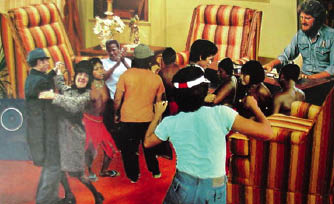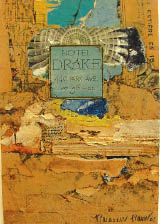Clip, Place & Paste
by Gerald Mead

Buffalonians were positively giddy in 2003 when the readers of AmericanStyle magazine ranked Buffalo #8 in their list of Top 25 Arts Destinations in the US. We moved up to #4 in 2004 and in 2006, after the categories were adjusted to account for varying city populations (we are in the mid-sized, 100,000-499,000 category), we soared to a backslapping #1.
With that in mind, it is interesting to note that when the National Collage Society was looking for a city to host its 10th Annual Collage Postcard Exhibition (it had been held at an art gallery in Lincoln Center in New York City since 2002), the answer was Buffalo. That exhibition is currently on view at Art Dialogue Gallery/Western New York Artists Group, thanks in part to Joyce Hill, a signature member of the Collage Society and board member of WNYAG, who lobbied for the show’s move to Buffalo. The gallery welcomed the exhibition as a means of introducing Western New York artists to a national arts organization as well as promoting cultural tourism.
Since it was founded in 1982, through exhibitions, publications and programs, the Collage Society has fostered appreciation and interest in collage, an art technique that is relatively recent as a fine art media. (Picasso is credited with having made the first collage in 1912 when he pasted a printed image of chair caning onto one of his canvases to accompany painted imagery and text.) The society’s postcard exhibition is an unjuried show of work by Collage Society members with the catchy title “Wish You Were Here.” The only criterion was that the collaged works be “post card size”—exactly four by six inches. (A number of the artists even riffed on that theme by incorporating stamps into their artworks.) What you’ll see on view at the gallery are 130 examples of tightly edited collages that have converged in Buffalo from 30 states across the US. If there is a variation of cutting, pasting and layering papers, images and objects, you’re likely to find it among the rows of side-by-side, identically sized artworks ringing the gallery and, for the most part, that is a good thing. Gallery Director Don Siuta’s decision to organize the work in random order was a wise one in that it, as he describes it, “evens the playing field.”

Manipulated photographic imagery features prominently among the works, and Andrew Donovan’s Dance Party, with its cross-cultural dancing figures cavorting in an oversized circa 1970s living room, reminded me of Richard Hamilton’s iconic 1950s pop art collage titled Just What Is It That Makes Today’s Homes So Different, So Appealing? Hamilton’s very famous collage, small itself—only about nine inches square—has been reproduced ad infinitum and consequently often serves as reference/inspiration to artists working in photo-based collage.
Scale, proportion and context are a collage artist’s playground and Lucy Redick uses these tools to good advantage in her work Leaps and Bounds, which shows tiny running figures from a Grecian urn leaping from skyscraper to skyscraper in the Toronto skyline, complete with an incongruous upward view of the CN Tower bisecting the scene from the bottom edge.
The themes of the collages range from prosaic to political. In his 24 square inches of collage real estate, Bill Kinsey from Virginia gives us 57 reasons not to be at war. This list, sandwiched between rows of revolutionary soldiers, inexplicably includes “scrambled eggs” and “crayons.” Also pushing the envelope as to how much content can be wedged into the limited scale of these works is Richard Martin Jacoby from California, who manages to fit onto his piece titled Vietnam Memorial the names, birth and death dates of 49 casualties of the Vietnam War.

There is also an abundance of the Kurt Schwitters’ brand of collage. Schwitters (1887-1948), generally acknowledged as the 20th century’s greatest master of collage, was known for his dense compositions of detritus—paper ephemera and scraps of refuse. A particularly effective example of one in this vein is Lisa Jones Moore’s Never Sent. Moore has found a way to incorporate into her collage a matchbox with a tiny image of the Venus de Milo on it, used and unused matches and a cigarette butt, and to make it work compositionally. Generally, the simpler approaches are the most successful in this show, such as one of the award-winners, Pennsylvania artist Fiel Patricio’s An Inner Promenade, with its black-and-white acetate image of trees overlaying handwritten text and flanked by torn paper borders of delicate bright green leaf patterns. It achieves complex illusory effects and intriguing combinations of materials with a modicum of elements.
Work by area artists are also represented in the exhibition, and Catherine Tillou of Buffalo is to be commended for her jewel-like photomontage of ornate gilded furniture, mirror and abundant floral arrangements floating against a richly patterned tapestry.
To accompany this exhibition, the gallery has put on display a small body of work by Beverly Goldsman, a respected senior artist in this region and signature member of the National Collage Society. Goldsman is know for her collage/assemblages that combine nostalgic (often hauntingly so) portraits with elements such as highly textured, rugged papers that have been handled in a manner that accentuates their age and patina. These soulful works are imbued with a sense of isolation and loss.
The strength of the National Exhibition is its breadth of expression in the media, and it succeeds in its aim to illustrate the multitude of approaches that are possible when artists explore techniques and strategies typically associated with the genre of collage.
|
Issue Navigation> Issue Index > v6n26: Recycle Your Cash (6/28/07) > Clip, Place & Paste This Week's Issue • Artvoice Daily • Artvoice TV • Events Calendar • Classifieds |









 Current Issue
Current Issue